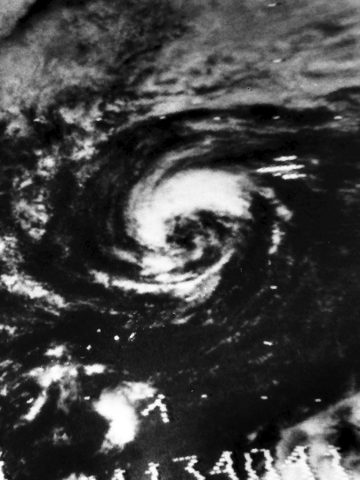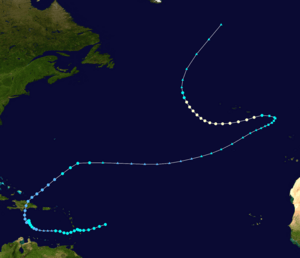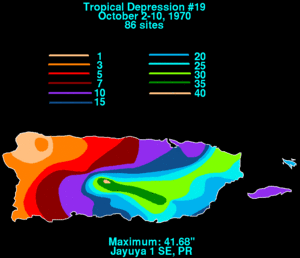1970 Caribbean–Azores hurricane facts for kids
| Category 1 hurricane (SSHWS/NWS) | |

Satellite image of the hurricane to the southwest of the Azores
|
|
| Formed | September 30, 1970 |
|---|---|
| Dissipated | October 22, 1970 |
| Highest winds | 1-minute sustained: 85 mph (140 km/h) |
| Lowest pressure | 989 mbar (hPa); 29.21 inHg |
| Fatalities | 22 total |
| Damage | > $65.5 million (1970 USD) |
| Areas affected | Lesser Antilles (especially Barbados and USVI), Puerto Rico |
| Part of the 1970 Atlantic hurricane season | |
The 1970 Caribbean-Azores Hurricane was a powerful storm that brought a lot of rain to Puerto Rico in 1970. It started near Africa on September 24 and traveled west. On October 1, it passed through the Lesser Antilles and then slowed down in the eastern Caribbean Sea. Later, on October 8, the storm moved over the Dominican Republic. It then sped up towards the northeast. The storm was no longer called a tropical cyclone by October 12, but its leftover parts continued for another week. They finally disappeared near the Azores islands.
This storm caused heavy rainfall in the Lesser Antilles. For example, Barbados received 12 inches (300 mm) of rain. This led to three people losing their lives and caused a lot of damage on the island. Another person died in the United States Virgin Islands. In Puerto Rico, the huge amount of rain caused about $65 million (in 1970 money) in damage. The town of Jayuya got the most rain, with 41.68 inches (1,059 mm) falling in total. A lot of this rain fell in just one day. Most of the damage was to sugar cane and coffee farms. At least 18 people died in Puerto Rico, and this storm was one of the worst disasters in the island's history.
Contents
How the Storm Formed and Moved
The storm began as a "tropical wave" over western Africa on September 22. A tropical wave is like a ripple in the air that can lead to storms. The next day, it moved off the coast of Africa. By September 24, it became a "tropical depression." This is a storm with winds that are not yet very strong. It was about 95 miles (153 km) southwest of Conakry, Guinea.
The depression moved west and slowly got stronger. By September 25, its winds reached 35 mph (56 km/h). An area of low pressure nearby stopped it from getting much stronger. On October 1, the storm hit the island of Saint Lucia. As it crossed the Lesser Antilles, its winds and air pressure were almost strong enough to be called a tropical storm.
In the Caribbean, the low-pressure area made the storm slow down. This caused several days of heavy rain, especially in Puerto Rico. On October 5, forecasters thought the storm would keep moving west towards Jamaica. But instead, it turned north the next day. This was because of strong winds high up in the atmosphere.
On October 7, the storm had its lowest pressure, which means it was at its strongest point. This was off the southern coast of Hispaniola. The next day, it made "landfall" in the Dominican Republic. Landfall means the center of the storm crossed onto land. After moving across the Dominican Republic and into the Atlantic Ocean, the storm sped up towards the northeast. It then turned east on October 10, before turning northeast again.
By October 12, the storm was no longer strong enough to be called a tropical cyclone. But satellite pictures showed that its leftover parts kept moving northeast. On October 15, the system turned west. This was because of a strong area of high pressure to its north. It got a bit stronger as it crossed through the Azores. It then turned northwest and was absorbed into other weather systems on October 20.
How People Prepared and What Happened
Around October 3, weather experts told people on islands like Barbados, St. Vincent, and Guadeloupe to get ready for floods, rough seas, and strong winds. On October 10, a warning was given to small plane owners in Puerto Rico and the Virgin Islands about strong winds.
As the storm moved through the islands, it brought a lot of rain. Saint Lucia got 8.90 inches (226 mm), Dominica got 2.19 inches (56 mm), and Barbados received 12 inches (300 mm). In Barbados, the storm left 200 people without homes. It caused $500,000 in damage and three people lost their lives.
Impact on Islands
The U.S. Virgin Islands also got very heavy rains. Saint John recorded 11.4 inches (290 mm) of rain. The rains caused floods everywhere, washing out roads and destroying some houses. One boy was swept away by the floodwaters but was saved by two people. Sadly, a girl was also swept away by the floods and drowned.
The plant that turns saltwater into drinking water on Saint Croix was damaged. This stopped the supply of drinking water for a while. Water had to be shipped from Puerto Rico to help. On St. Thomas, the main airport was closed for several days.
Puerto Rico's Big Rain
For six days, the storm dropped rain across the northern Caribbean, especially in Puerto Rico. The highest amount of rain was 41.68 inches (1,059 mm). This was recorded near Jayuya in the center of the island. This was the most rain ever recorded from a tropical storm in Puerto Rico's history. It was even more than the deadly hurricanes of 1928 and 1899. The station in Jayuya also recorded 17 inches (430 mm) of rain in just 24 hours. Four other places also reported over 30 inches (760 mm) of rain. All this heavy rain caused 20 rivers to overflow their banks.
The storm left 10,000 people homeless across Puerto Rico. About 3,000 people stayed in emergency shelters in San Juan. At least 600 houses were destroyed, and another 1,000 were damaged. The damage was very bad in places like Barceloneta, Aibonito, and Coamo.
Across the island, the storm affected at least 40 state roads. Fifteen roads were blocked by landslides, and eleven bridges were destroyed. Flooding forced the closure of Puerto Rico Highway 2 between Manatí and Barceloneta. The storm caused more than $40 million (in 1970 money) in damage to crops. This was mainly to sugar cane and coffee farms. In total, the storm caused about $65 million (in 1970 money) in damage in Puerto Rico. At least 18 people lost their lives. Six months after the storm, 34 people were still missing.
Helping After the Storm
After the disaster, Luis A. Ferré, who was the Governor of Puerto Rico, declared a "state of emergency" for the whole island. This meant he asked for $10 million (in 1970 money) in help from the government. On October 12, President Richard Nixon declared Puerto Rico a disaster area. Governor Ferré also held a special TV event to raise money for those who lost their homes.
The National Guard, the Red Cross, and other volunteer groups helped the people who were displaced. Overall, this disaster was one of the worst in Puerto Rico's history. The Governor of the Virgin Islands, Melvin Evans, also asked for help. That territory was also declared a federal disaster area about a week after the rains stopped. The heavy rain in the Virgin Islands also caused a lot of tiny sea plants called "dinoflagellates" to grow rapidly in the days after the storm.



